Fundamentals of Economics (ECO211) Report: Macroeconomic Issues
VerifiedAdded on 2022/02/04
|13
|4313
|42
Report
AI Summary
This ECO211 report, prepared by a group of students, delves into the major macroeconomic problems of inflation and unemployment. The introduction defines these issues, explaining their causes and consequences, including the impact on purchasing power and the labor market. The report then analyzes the current macroeconomic problems in Malaysia, discussing the factors contributing to inflation, such as the depreciation of the ringgit and the impact of the Goods and Services Tax (GST). It also examines unemployment, including the influence of foreign workers and the skills gap. The report further explores the effects of these problems on living standards, the function of money, and the economy. The report includes a section on measures to overcome the microeconomic problems. The report concludes by summarizing the key findings and implications of these macroeconomic challenges, offering a comprehensive overview of the economic situation and potential solutions.
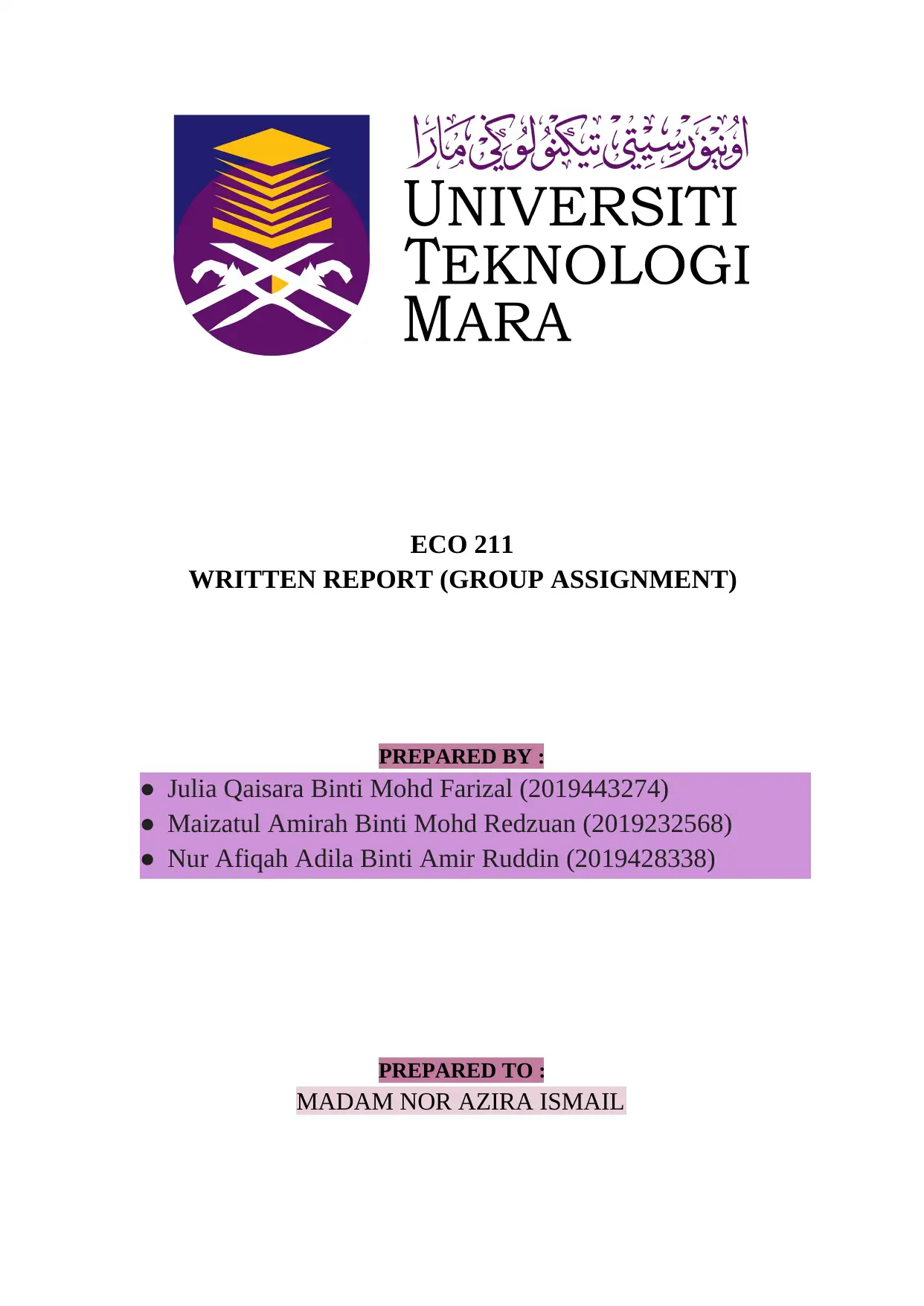
ECO 211
WRITTEN REPORT (GROUP ASSIGNMENT)
PREPARED BY :
● Julia Qaisara Binti Mohd Farizal (2019443274)
● Maizatul Amirah Binti Mohd Redzuan (2019232568)
● Nur Afiqah Adila Binti Amir Ruddin (2019428338)
PREPARED TO :
MADAM NOR AZIRA ISMAIL
WRITTEN REPORT (GROUP ASSIGNMENT)
PREPARED BY :
● Julia Qaisara Binti Mohd Farizal (2019443274)
● Maizatul Amirah Binti Mohd Redzuan (2019232568)
● Nur Afiqah Adila Binti Amir Ruddin (2019428338)
PREPARED TO :
MADAM NOR AZIRA ISMAIL
Paraphrase This Document
Need a fresh take? Get an instant paraphrase of this document with our AI Paraphraser
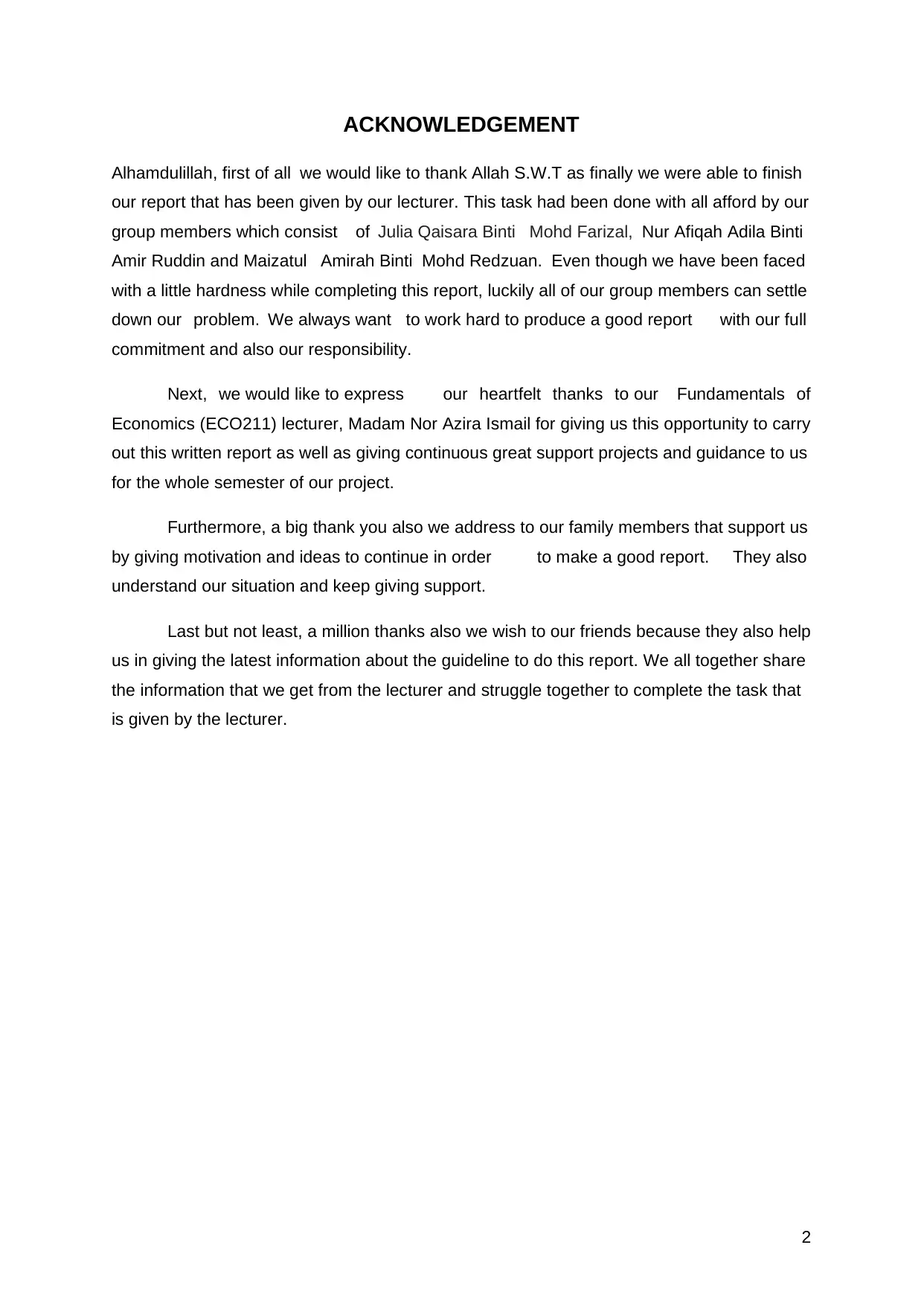
ACKNOWLEDGEMENT
Alhamdulillah, first of all we would like to thank Allah S.W.T as finally we were able to finish
our report that has been given by our lecturer. This task had been done with all afford by our
group members which consist of Julia Qaisara Binti Mohd Farizal, Nur Afiqah Adila Binti
Amir Ruddin and Maizatul Amirah Binti Mohd Redzuan. Even though we have been faced
with a little hardness while completing this report, luckily all of our group members can settle
down our problem. We always want to work hard to produce a good report with our full
commitment and also our responsibility.
Next, we would like to express our heartfelt thanks to our Fundamentals of
Economics (ECO211) lecturer, Madam Nor Azira Ismail for giving us this opportunity to carry
out this written report as well as giving continuous great support projects and guidance to us
for the whole semester of our project.
Furthermore, a big thank you also we address to our family members that support us
by giving motivation and ideas to continue in order to make a good report. They also
understand our situation and keep giving support.
Last but not least, a million thanks also we wish to our friends because they also help
us in giving the latest information about the guideline to do this report. We all together share
the information that we get from the lecturer and struggle together to complete the task that
is given by the lecturer.
2
Alhamdulillah, first of all we would like to thank Allah S.W.T as finally we were able to finish
our report that has been given by our lecturer. This task had been done with all afford by our
group members which consist of Julia Qaisara Binti Mohd Farizal, Nur Afiqah Adila Binti
Amir Ruddin and Maizatul Amirah Binti Mohd Redzuan. Even though we have been faced
with a little hardness while completing this report, luckily all of our group members can settle
down our problem. We always want to work hard to produce a good report with our full
commitment and also our responsibility.
Next, we would like to express our heartfelt thanks to our Fundamentals of
Economics (ECO211) lecturer, Madam Nor Azira Ismail for giving us this opportunity to carry
out this written report as well as giving continuous great support projects and guidance to us
for the whole semester of our project.
Furthermore, a big thank you also we address to our family members that support us
by giving motivation and ideas to continue in order to make a good report. They also
understand our situation and keep giving support.
Last but not least, a million thanks also we wish to our friends because they also help
us in giving the latest information about the guideline to do this report. We all together share
the information that we get from the lecturer and struggle together to complete the task that
is given by the lecturer.
2
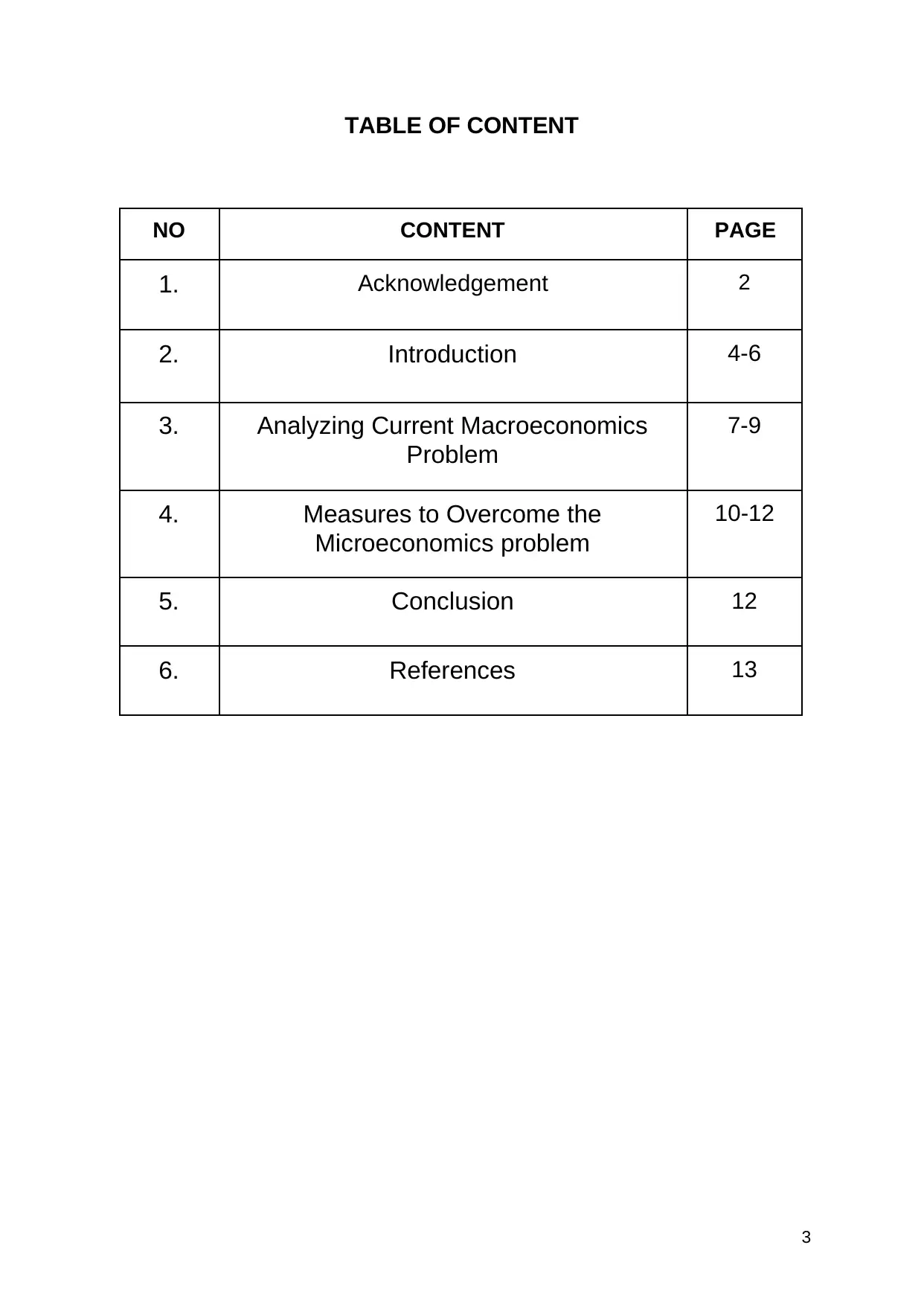
TABLE OF CONTENT
NO CONTENT PAGE
1. Acknowledgement 2
2. Introduction 4-6
3. Analyzing Current Macroeconomics
Problem
7-9
4. Measures to Overcome the
Microeconomics problem
10-12
5. Conclusion 12
6. References 13
3
NO CONTENT PAGE
1. Acknowledgement 2
2. Introduction 4-6
3. Analyzing Current Macroeconomics
Problem
7-9
4. Measures to Overcome the
Microeconomics problem
10-12
5. Conclusion 12
6. References 13
3
⊘ This is a preview!⊘
Do you want full access?
Subscribe today to unlock all pages.

Trusted by 1+ million students worldwide
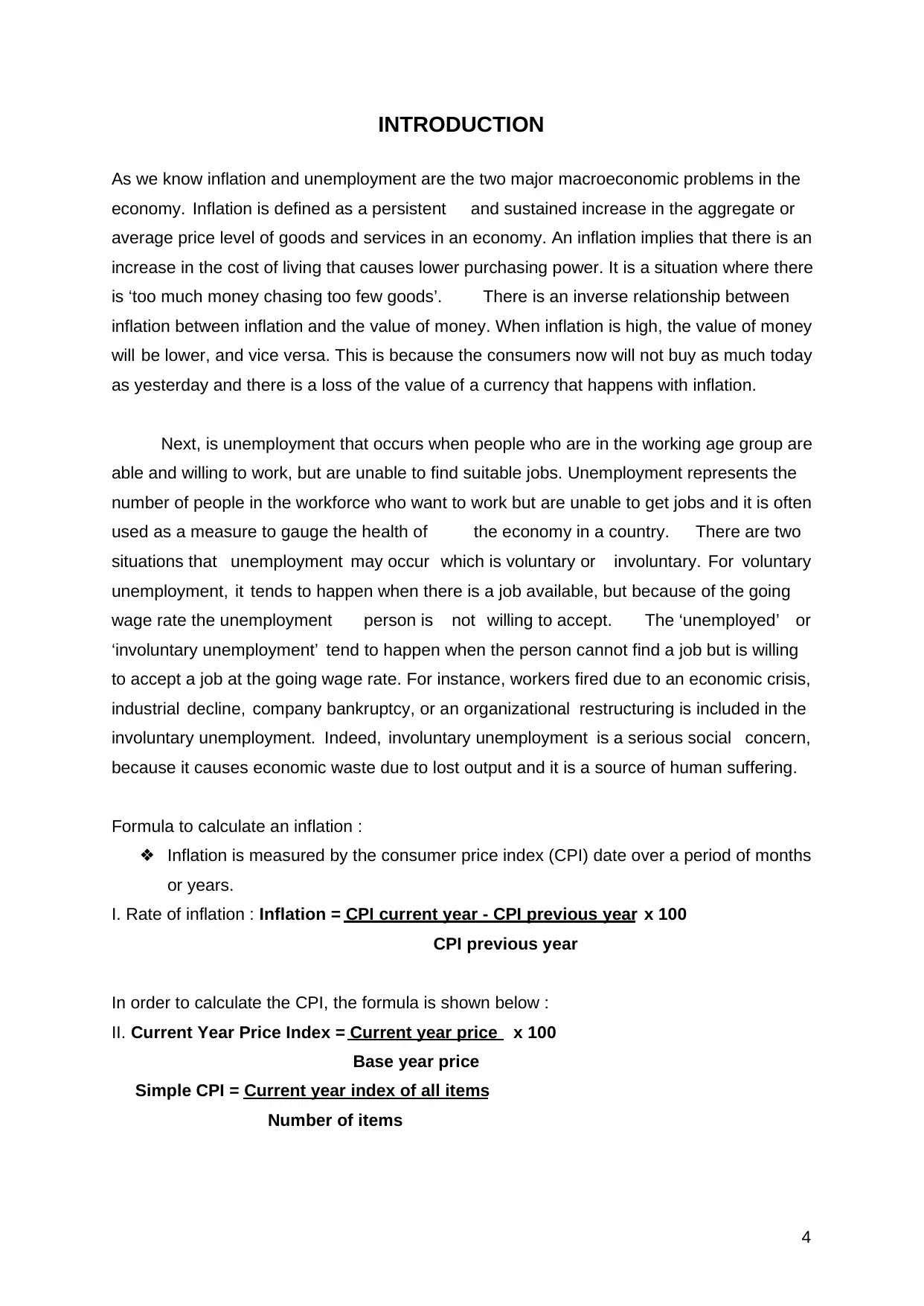
INTRODUCTION
As we know inflation and unemployment are the two major macroeconomic problems in the
economy. Inflation is defined as a persistent and sustained increase in the aggregate or
average price level of goods and services in an economy. An inflation implies that there is an
increase in the cost of living that causes lower purchasing power. It is a situation where there
is ‘too much money chasing too few goods’. There is an inverse relationship between
inflation between inflation and the value of money. When inflation is high, the value of money
will be lower, and vice versa. This is because the consumers now will not buy as much today
as yesterday and there is a loss of the value of a currency that happens with inflation.
Next, is unemployment that occurs when people who are in the working age group are
able and willing to work, but are unable to find suitable jobs. Unemployment represents the
number of people in the workforce who want to work but are unable to get jobs and it is often
used as a measure to gauge the health of the economy in a country. There are two
situations that unemployment may occur which is voluntary or involuntary. For voluntary
unemployment, it tends to happen when there is a job available, but because of the going
wage rate the unemployment person is not willing to accept. The ‘unemployed’ or
‘involuntary unemployment’ tend to happen when the person cannot find a job but is willing
to accept a job at the going wage rate. For instance, workers fired due to an economic crisis,
industrial decline, company bankruptcy, or an organizational restructuring is included in the
involuntary unemployment. Indeed, involuntary unemployment is a serious social concern,
because it causes economic waste due to lost output and it is a source of human suffering.
Formula to calculate an inflation :
❖ Inflation is measured by the consumer price index (CPI) date over a period of months
or years.
I. Rate of inflation : Inflation = CPI current year - CPI previous year x 100
CPI previous year
In order to calculate the CPI, the formula is shown below :
II. Current Year Price Index = Current year price x 100
Base year price
Simple CPI = Current year index of all items
Number of items
4
As we know inflation and unemployment are the two major macroeconomic problems in the
economy. Inflation is defined as a persistent and sustained increase in the aggregate or
average price level of goods and services in an economy. An inflation implies that there is an
increase in the cost of living that causes lower purchasing power. It is a situation where there
is ‘too much money chasing too few goods’. There is an inverse relationship between
inflation between inflation and the value of money. When inflation is high, the value of money
will be lower, and vice versa. This is because the consumers now will not buy as much today
as yesterday and there is a loss of the value of a currency that happens with inflation.
Next, is unemployment that occurs when people who are in the working age group are
able and willing to work, but are unable to find suitable jobs. Unemployment represents the
number of people in the workforce who want to work but are unable to get jobs and it is often
used as a measure to gauge the health of the economy in a country. There are two
situations that unemployment may occur which is voluntary or involuntary. For voluntary
unemployment, it tends to happen when there is a job available, but because of the going
wage rate the unemployment person is not willing to accept. The ‘unemployed’ or
‘involuntary unemployment’ tend to happen when the person cannot find a job but is willing
to accept a job at the going wage rate. For instance, workers fired due to an economic crisis,
industrial decline, company bankruptcy, or an organizational restructuring is included in the
involuntary unemployment. Indeed, involuntary unemployment is a serious social concern,
because it causes economic waste due to lost output and it is a source of human suffering.
Formula to calculate an inflation :
❖ Inflation is measured by the consumer price index (CPI) date over a period of months
or years.
I. Rate of inflation : Inflation = CPI current year - CPI previous year x 100
CPI previous year
In order to calculate the CPI, the formula is shown below :
II. Current Year Price Index = Current year price x 100
Base year price
Simple CPI = Current year index of all items
Number of items
4
Paraphrase This Document
Need a fresh take? Get an instant paraphrase of this document with our AI Paraphraser
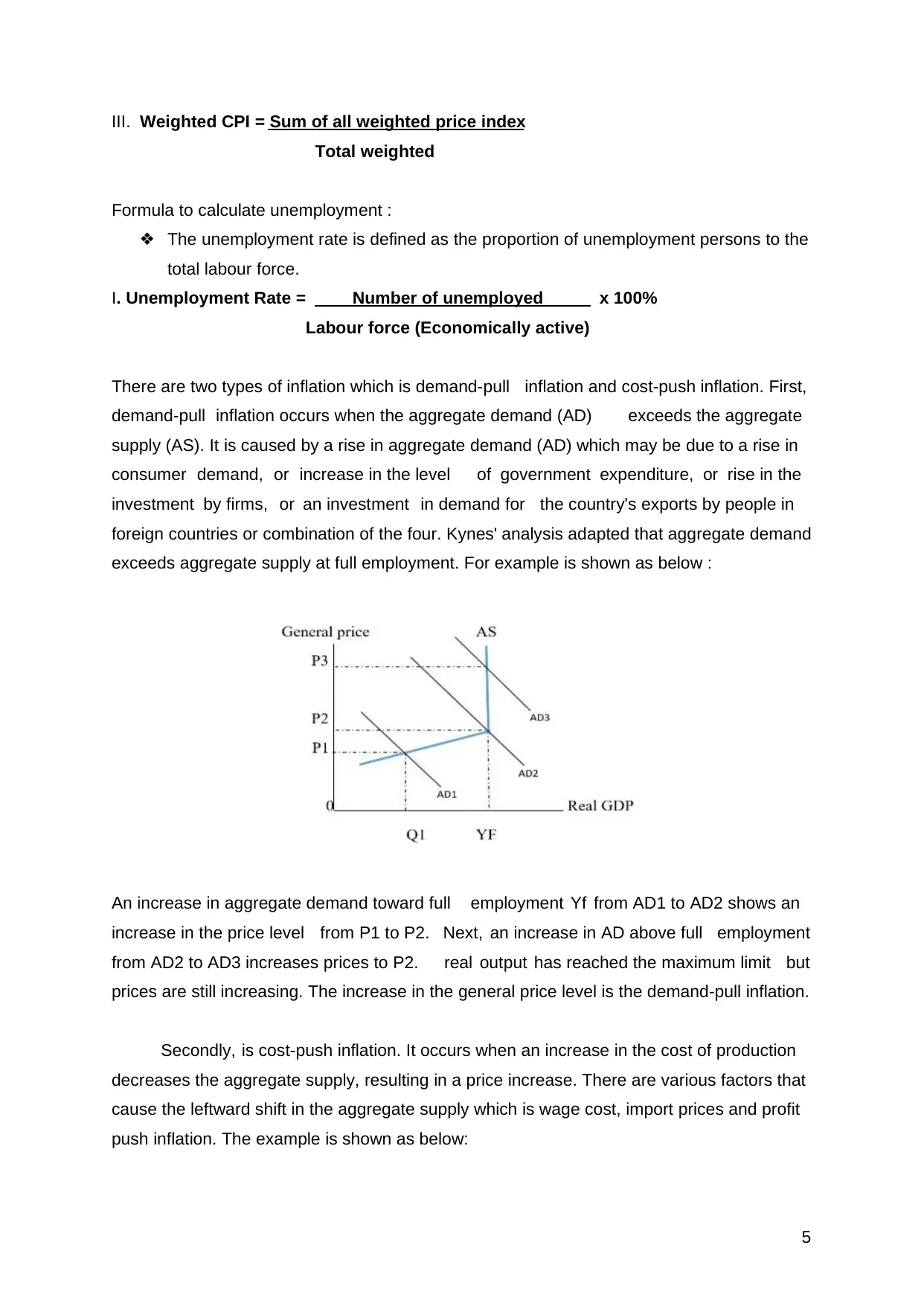
III. Weighted CPI = Sum of all weighted price index
Total weighted
Formula to calculate unemployment :
❖ The unemployment rate is defined as the proportion of unemployment persons to the
total labour force.
I. Unemployment Rate = Number of unemployed x 100%
Labour force (Economically active)
There are two types of inflation which is demand-pull inflation and cost-push inflation. First,
demand-pull inflation occurs when the aggregate demand (AD) exceeds the aggregate
supply (AS). It is caused by a rise in aggregate demand (AD) which may be due to a rise in
consumer demand, or increase in the level of government expenditure, or rise in the
investment by firms, or an investment in demand for the country's exports by people in
foreign countries or combination of the four. Kynes' analysis adapted that aggregate demand
exceeds aggregate supply at full employment. For example is shown as below :
An increase in aggregate demand toward full employment Yf from AD1 to AD2 shows an
increase in the price level from P1 to P2. Next, an increase in AD above full employment
from AD2 to AD3 increases prices to P2. real output has reached the maximum limit but
prices are still increasing. The increase in the general price level is the demand-pull inflation.
Secondly, is cost-push inflation. It occurs when an increase in the cost of production
decreases the aggregate supply, resulting in a price increase. There are various factors that
cause the leftward shift in the aggregate supply which is wage cost, import prices and profit
push inflation. The example is shown as below:
5
Total weighted
Formula to calculate unemployment :
❖ The unemployment rate is defined as the proportion of unemployment persons to the
total labour force.
I. Unemployment Rate = Number of unemployed x 100%
Labour force (Economically active)
There are two types of inflation which is demand-pull inflation and cost-push inflation. First,
demand-pull inflation occurs when the aggregate demand (AD) exceeds the aggregate
supply (AS). It is caused by a rise in aggregate demand (AD) which may be due to a rise in
consumer demand, or increase in the level of government expenditure, or rise in the
investment by firms, or an investment in demand for the country's exports by people in
foreign countries or combination of the four. Kynes' analysis adapted that aggregate demand
exceeds aggregate supply at full employment. For example is shown as below :
An increase in aggregate demand toward full employment Yf from AD1 to AD2 shows an
increase in the price level from P1 to P2. Next, an increase in AD above full employment
from AD2 to AD3 increases prices to P2. real output has reached the maximum limit but
prices are still increasing. The increase in the general price level is the demand-pull inflation.
Secondly, is cost-push inflation. It occurs when an increase in the cost of production
decreases the aggregate supply, resulting in a price increase. There are various factors that
cause the leftward shift in the aggregate supply which is wage cost, import prices and profit
push inflation. The example is shown as below:
5
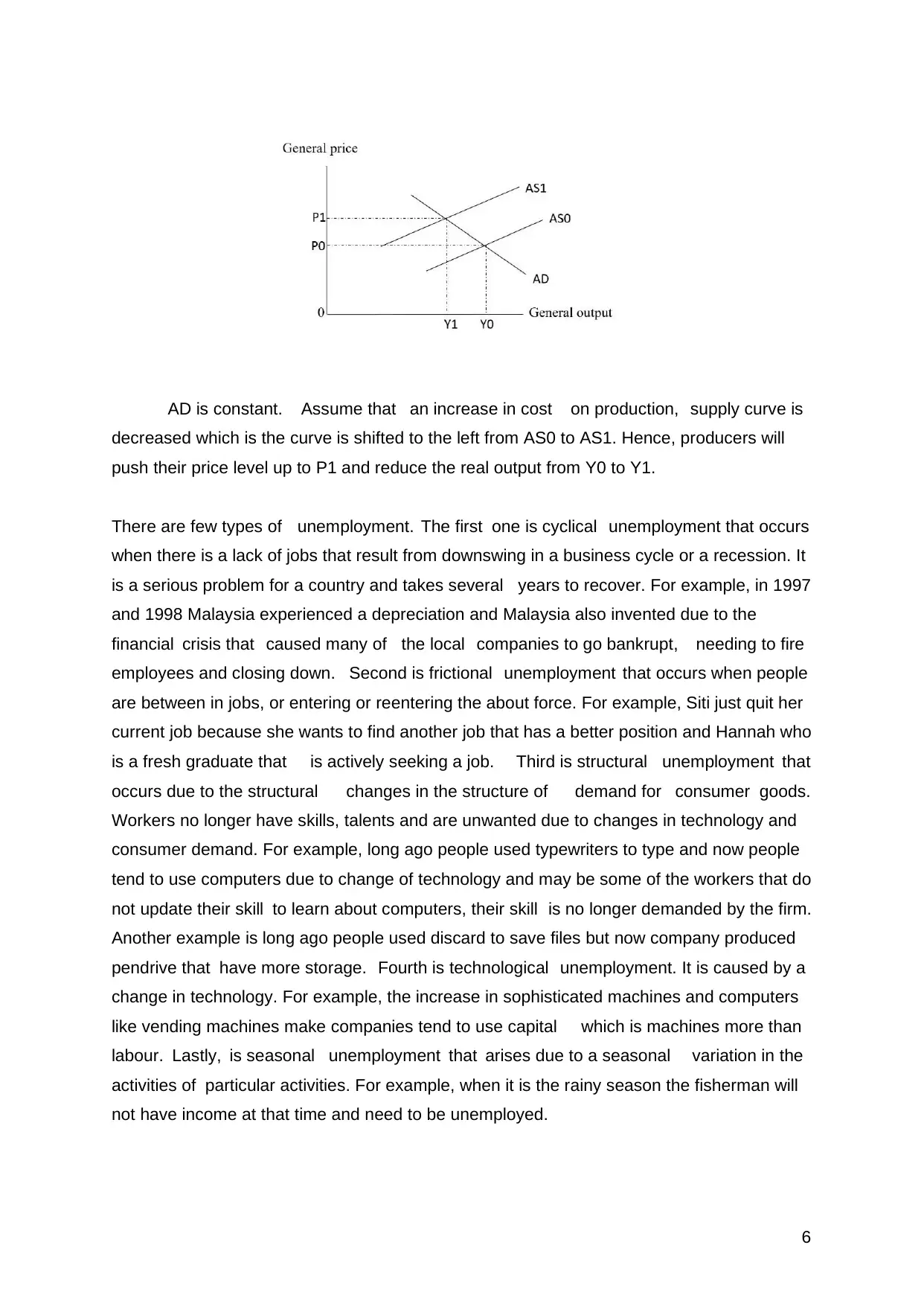
AD is constant. Assume that an increase in cost on production, supply curve is
decreased which is the curve is shifted to the left from AS0 to AS1. Hence, producers will
push their price level up to P1 and reduce the real output from Y0 to Y1.
There are few types of unemployment. The first one is cyclical unemployment that occurs
when there is a lack of jobs that result from downswing in a business cycle or a recession. It
is a serious problem for a country and takes several years to recover. For example, in 1997
and 1998 Malaysia experienced a depreciation and Malaysia also invented due to the
financial crisis that caused many of the local companies to go bankrupt, needing to fire
employees and closing down. Second is frictional unemployment that occurs when people
are between in jobs, or entering or reentering the about force. For example, Siti just quit her
current job because she wants to find another job that has a better position and Hannah who
is a fresh graduate that is actively seeking a job. Third is structural unemployment that
occurs due to the structural changes in the structure of demand for consumer goods.
Workers no longer have skills, talents and are unwanted due to changes in technology and
consumer demand. For example, long ago people used typewriters to type and now people
tend to use computers due to change of technology and may be some of the workers that do
not update their skill to learn about computers, their skill is no longer demanded by the firm.
Another example is long ago people used discard to save files but now company produced
pendrive that have more storage. Fourth is technological unemployment. It is caused by a
change in technology. For example, the increase in sophisticated machines and computers
like vending machines make companies tend to use capital which is machines more than
labour. Lastly, is seasonal unemployment that arises due to a seasonal variation in the
activities of particular activities. For example, when it is the rainy season the fisherman will
not have income at that time and need to be unemployed.
6
decreased which is the curve is shifted to the left from AS0 to AS1. Hence, producers will
push their price level up to P1 and reduce the real output from Y0 to Y1.
There are few types of unemployment. The first one is cyclical unemployment that occurs
when there is a lack of jobs that result from downswing in a business cycle or a recession. It
is a serious problem for a country and takes several years to recover. For example, in 1997
and 1998 Malaysia experienced a depreciation and Malaysia also invented due to the
financial crisis that caused many of the local companies to go bankrupt, needing to fire
employees and closing down. Second is frictional unemployment that occurs when people
are between in jobs, or entering or reentering the about force. For example, Siti just quit her
current job because she wants to find another job that has a better position and Hannah who
is a fresh graduate that is actively seeking a job. Third is structural unemployment that
occurs due to the structural changes in the structure of demand for consumer goods.
Workers no longer have skills, talents and are unwanted due to changes in technology and
consumer demand. For example, long ago people used typewriters to type and now people
tend to use computers due to change of technology and may be some of the workers that do
not update their skill to learn about computers, their skill is no longer demanded by the firm.
Another example is long ago people used discard to save files but now company produced
pendrive that have more storage. Fourth is technological unemployment. It is caused by a
change in technology. For example, the increase in sophisticated machines and computers
like vending machines make companies tend to use capital which is machines more than
labour. Lastly, is seasonal unemployment that arises due to a seasonal variation in the
activities of particular activities. For example, when it is the rainy season the fisherman will
not have income at that time and need to be unemployed.
6
⊘ This is a preview!⊘
Do you want full access?
Subscribe today to unlock all pages.

Trusted by 1+ million students worldwide
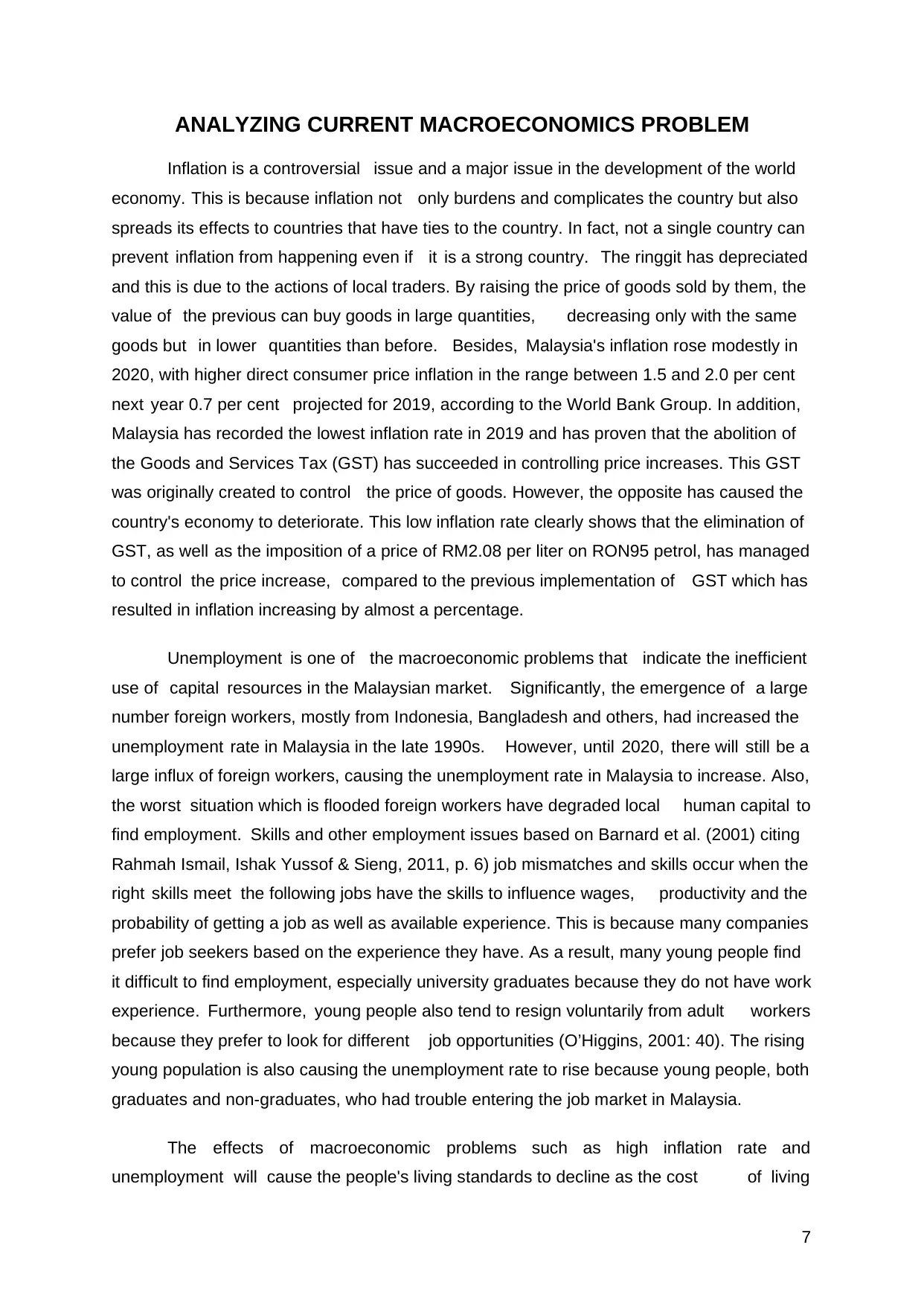
ANALYZING CURRENT MACROECONOMICS PROBLEM
Inflation is a controversial issue and a major issue in the development of the world
economy. This is because inflation not only burdens and complicates the country but also
spreads its effects to countries that have ties to the country. In fact, not a single country can
prevent inflation from happening even if it is a strong country. The ringgit has depreciated
and this is due to the actions of local traders. By raising the price of goods sold by them, the
value of the previous can buy goods in large quantities, decreasing only with the same
goods but in lower quantities than before. Besides, Malaysia's inflation rose modestly in
2020, with higher direct consumer price inflation in the range between 1.5 and 2.0 per cent
next year 0.7 per cent projected for 2019, according to the World Bank Group. In addition,
Malaysia has recorded the lowest inflation rate in 2019 and has proven that the abolition of
the Goods and Services Tax (GST) has succeeded in controlling price increases. This GST
was originally created to control the price of goods. However, the opposite has caused the
country's economy to deteriorate. This low inflation rate clearly shows that the elimination of
GST, as well as the imposition of a price of RM2.08 per liter on RON95 petrol, has managed
to control the price increase, compared to the previous implementation of GST which has
resulted in inflation increasing by almost a percentage.
Unemployment is one of the macroeconomic problems that indicate the inefficient
use of capital resources in the Malaysian market. Significantly, the emergence of a large
number foreign workers, mostly from Indonesia, Bangladesh and others, had increased the
unemployment rate in Malaysia in the late 1990s. However, until 2020, there will still be a
large influx of foreign workers, causing the unemployment rate in Malaysia to increase. Also,
the worst situation which is flooded foreign workers have degraded local human capital to
find employment. Skills and other employment issues based on Barnard et al. (2001) citing
Rahmah Ismail, Ishak Yussof & Sieng, 2011, p. 6) job mismatches and skills occur when the
right skills meet the following jobs have the skills to influence wages, productivity and the
probability of getting a job as well as available experience. This is because many companies
prefer job seekers based on the experience they have. As a result, many young people find
it difficult to find employment, especially university graduates because they do not have work
experience. Furthermore, young people also tend to resign voluntarily from adult workers
because they prefer to look for different job opportunities (O’Higgins, 2001: 40). The rising
young population is also causing the unemployment rate to rise because young people, both
graduates and non-graduates, who had trouble entering the job market in Malaysia.
The effects of macroeconomic problems such as high inflation rate and
unemployment will cause the people's living standards to decline as the cost of living
7
Inflation is a controversial issue and a major issue in the development of the world
economy. This is because inflation not only burdens and complicates the country but also
spreads its effects to countries that have ties to the country. In fact, not a single country can
prevent inflation from happening even if it is a strong country. The ringgit has depreciated
and this is due to the actions of local traders. By raising the price of goods sold by them, the
value of the previous can buy goods in large quantities, decreasing only with the same
goods but in lower quantities than before. Besides, Malaysia's inflation rose modestly in
2020, with higher direct consumer price inflation in the range between 1.5 and 2.0 per cent
next year 0.7 per cent projected for 2019, according to the World Bank Group. In addition,
Malaysia has recorded the lowest inflation rate in 2019 and has proven that the abolition of
the Goods and Services Tax (GST) has succeeded in controlling price increases. This GST
was originally created to control the price of goods. However, the opposite has caused the
country's economy to deteriorate. This low inflation rate clearly shows that the elimination of
GST, as well as the imposition of a price of RM2.08 per liter on RON95 petrol, has managed
to control the price increase, compared to the previous implementation of GST which has
resulted in inflation increasing by almost a percentage.
Unemployment is one of the macroeconomic problems that indicate the inefficient
use of capital resources in the Malaysian market. Significantly, the emergence of a large
number foreign workers, mostly from Indonesia, Bangladesh and others, had increased the
unemployment rate in Malaysia in the late 1990s. However, until 2020, there will still be a
large influx of foreign workers, causing the unemployment rate in Malaysia to increase. Also,
the worst situation which is flooded foreign workers have degraded local human capital to
find employment. Skills and other employment issues based on Barnard et al. (2001) citing
Rahmah Ismail, Ishak Yussof & Sieng, 2011, p. 6) job mismatches and skills occur when the
right skills meet the following jobs have the skills to influence wages, productivity and the
probability of getting a job as well as available experience. This is because many companies
prefer job seekers based on the experience they have. As a result, many young people find
it difficult to find employment, especially university graduates because they do not have work
experience. Furthermore, young people also tend to resign voluntarily from adult workers
because they prefer to look for different job opportunities (O’Higgins, 2001: 40). The rising
young population is also causing the unemployment rate to rise because young people, both
graduates and non-graduates, who had trouble entering the job market in Malaysia.
The effects of macroeconomic problems such as high inflation rate and
unemployment will cause the people's living standards to decline as the cost of living
7
Paraphrase This Document
Need a fresh take? Get an instant paraphrase of this document with our AI Paraphraser
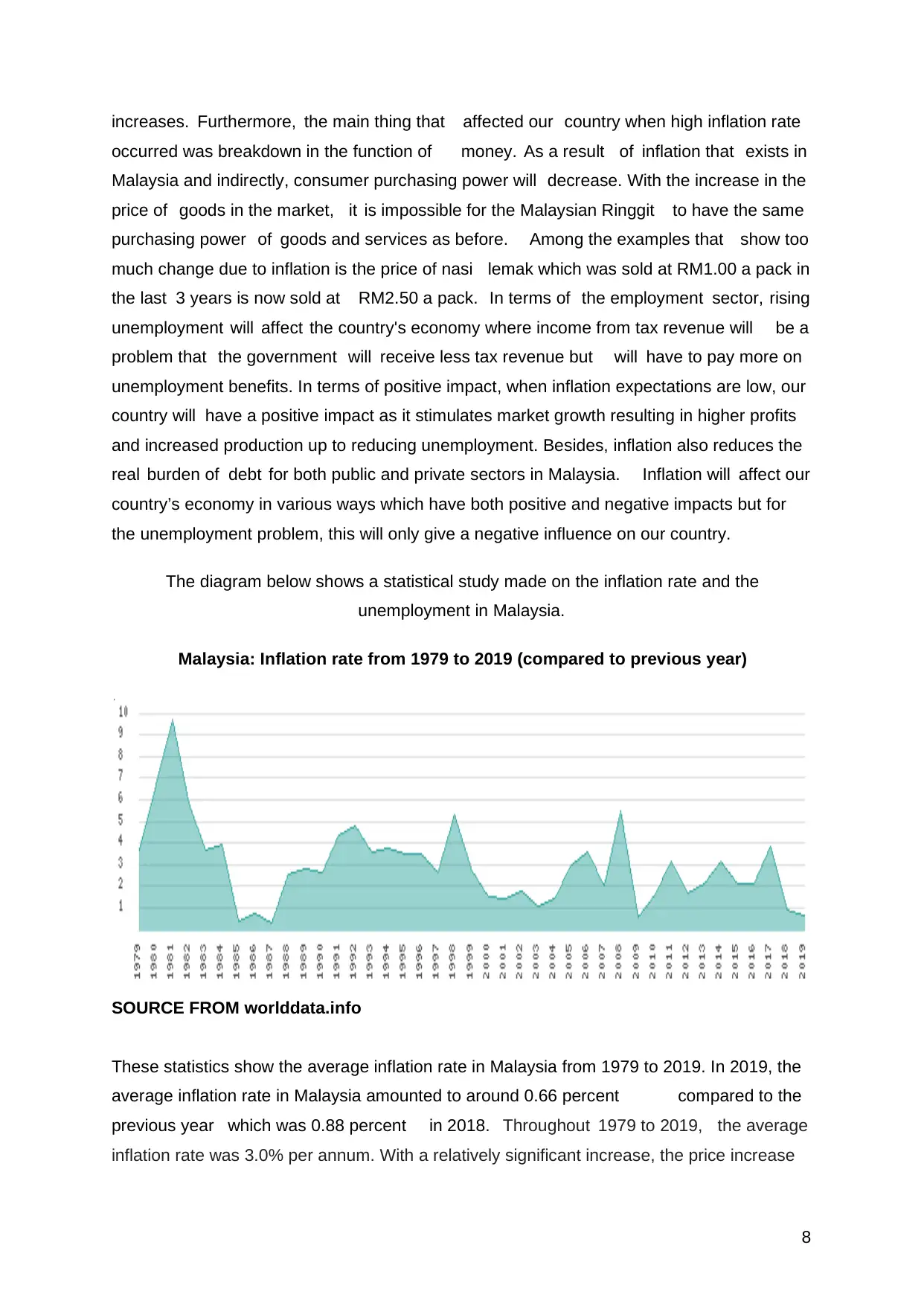
increases. Furthermore, the main thing that affected our country when high inflation rate
occurred was breakdown in the function of money. As a result of inflation that exists in
Malaysia and indirectly, consumer purchasing power will decrease. With the increase in the
price of goods in the market, it is impossible for the Malaysian Ringgit to have the same
purchasing power of goods and services as before. Among the examples that show too
much change due to inflation is the price of nasi lemak which was sold at RM1.00 a pack in
the last 3 years is now sold at RM2.50 a pack. In terms of the employment sector, rising
unemployment will affect the country's economy where income from tax revenue will be a
problem that the government will receive less tax revenue but will have to pay more on
unemployment benefits. In terms of positive impact, when inflation expectations are low, our
country will have a positive impact as it stimulates market growth resulting in higher profits
and increased production up to reducing unemployment. Besides, inflation also reduces the
real burden of debt for both public and private sectors in Malaysia. Inflation will affect our
country’s economy in various ways which have both positive and negative impacts but for
the unemployment problem, this will only give a negative influence on our country.
The diagram below shows a statistical study made on the inflation rate and the
unemployment in Malaysia.
Malaysia: Inflation rate from 1979 to 2019 (compared to previous year)
SOURCE FROM worlddata.info
These statistics show the average inflation rate in Malaysia from 1979 to 2019. In 2019, the
average inflation rate in Malaysia amounted to around 0.66 percent compared to the
previous year which was 0.88 percent in 2018. Throughout 1979 to 2019, the average
inflation rate was 3.0% per annum. With a relatively significant increase, the price increase
8
occurred was breakdown in the function of money. As a result of inflation that exists in
Malaysia and indirectly, consumer purchasing power will decrease. With the increase in the
price of goods in the market, it is impossible for the Malaysian Ringgit to have the same
purchasing power of goods and services as before. Among the examples that show too
much change due to inflation is the price of nasi lemak which was sold at RM1.00 a pack in
the last 3 years is now sold at RM2.50 a pack. In terms of the employment sector, rising
unemployment will affect the country's economy where income from tax revenue will be a
problem that the government will receive less tax revenue but will have to pay more on
unemployment benefits. In terms of positive impact, when inflation expectations are low, our
country will have a positive impact as it stimulates market growth resulting in higher profits
and increased production up to reducing unemployment. Besides, inflation also reduces the
real burden of debt for both public and private sectors in Malaysia. Inflation will affect our
country’s economy in various ways which have both positive and negative impacts but for
the unemployment problem, this will only give a negative influence on our country.
The diagram below shows a statistical study made on the inflation rate and the
unemployment in Malaysia.
Malaysia: Inflation rate from 1979 to 2019 (compared to previous year)
SOURCE FROM worlddata.info
These statistics show the average inflation rate in Malaysia from 1979 to 2019. In 2019, the
average inflation rate in Malaysia amounted to around 0.66 percent compared to the
previous year which was 0.88 percent in 2018. Throughout 1979 to 2019, the average
inflation rate was 3.0% per annum. With a relatively significant increase, the price increase
8
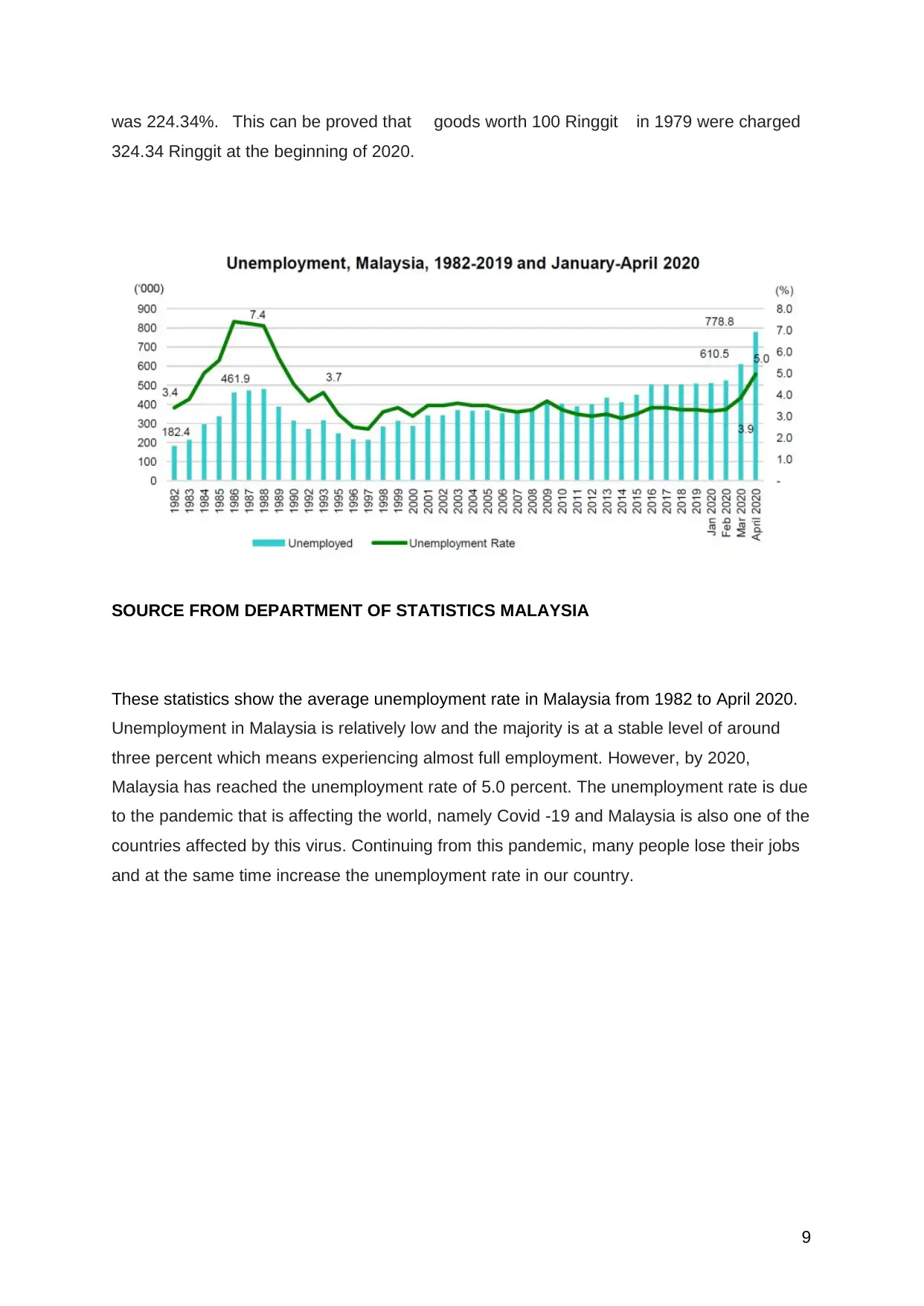
was 224.34%. This can be proved that goods worth 100 Ringgit in 1979 were charged
324.34 Ringgit at the beginning of 2020.
SOURCE FROM DEPARTMENT OF STATISTICS MALAYSIA
These statistics show the average unemployment rate in Malaysia from 1982 to April 2020.
Unemployment in Malaysia is relatively low and the majority is at a stable level of around
three percent which means experiencing almost full employment. However, by 2020,
Malaysia has reached the unemployment rate of 5.0 percent. The unemployment rate is due
to the pandemic that is affecting the world, namely Covid -19 and Malaysia is also one of the
countries affected by this virus. Continuing from this pandemic, many people lose their jobs
and at the same time increase the unemployment rate in our country.
9
324.34 Ringgit at the beginning of 2020.
SOURCE FROM DEPARTMENT OF STATISTICS MALAYSIA
These statistics show the average unemployment rate in Malaysia from 1982 to April 2020.
Unemployment in Malaysia is relatively low and the majority is at a stable level of around
three percent which means experiencing almost full employment. However, by 2020,
Malaysia has reached the unemployment rate of 5.0 percent. The unemployment rate is due
to the pandemic that is affecting the world, namely Covid -19 and Malaysia is also one of the
countries affected by this virus. Continuing from this pandemic, many people lose their jobs
and at the same time increase the unemployment rate in our country.
9
⊘ This is a preview!⊘
Do you want full access?
Subscribe today to unlock all pages.

Trusted by 1+ million students worldwide
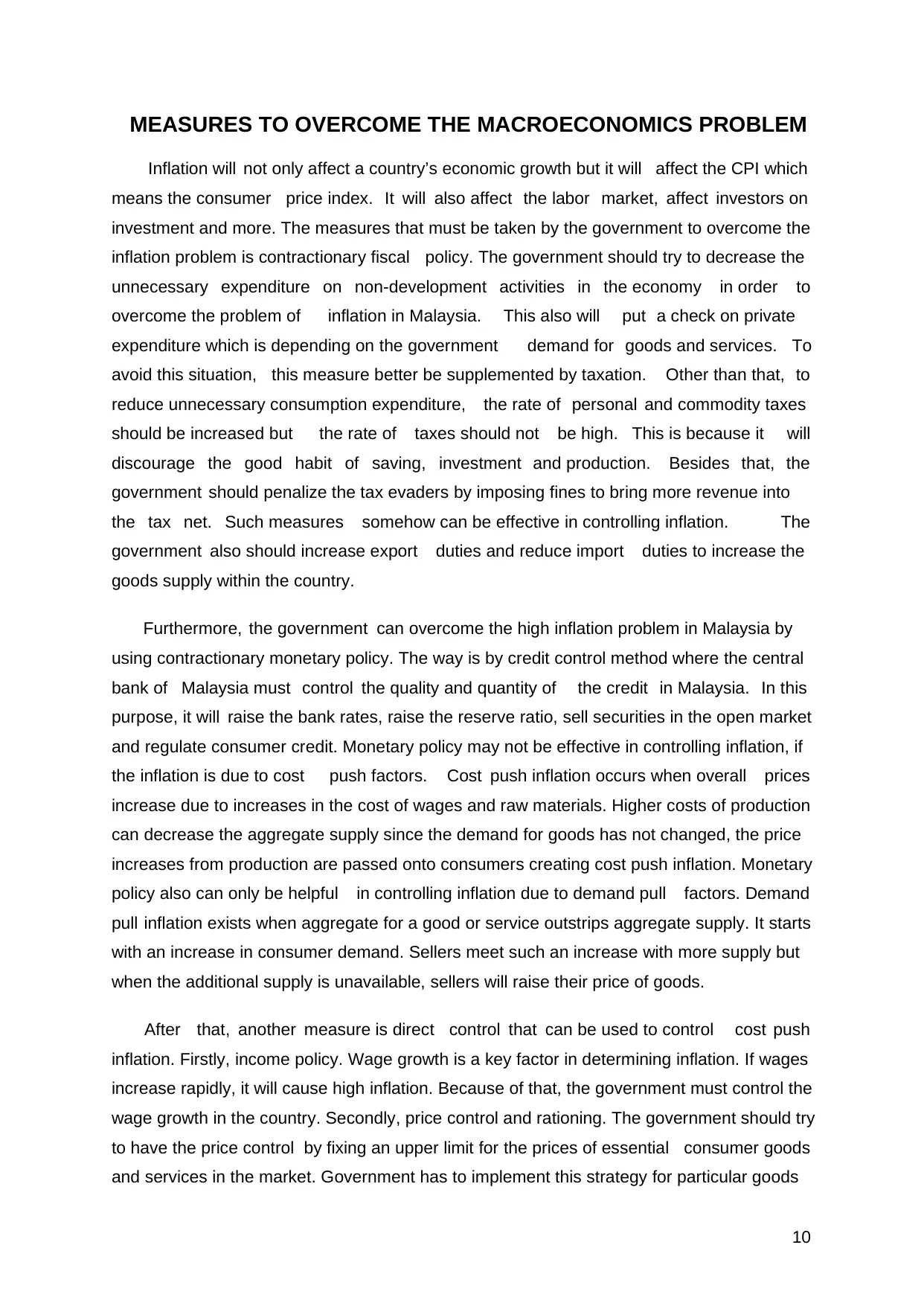
MEASURES TO OVERCOME THE MACROECONOMICS PROBLEM
Inflation will not only affect a country’s economic growth but it will affect the CPI which
means the consumer price index. It will also affect the labor market, affect investors on
investment and more. The measures that must be taken by the government to overcome the
inflation problem is contractionary fiscal policy. The government should try to decrease the
unnecessary expenditure on non-development activities in the economy in order to
overcome the problem of inflation in Malaysia. This also will put a check on private
expenditure which is depending on the government demand for goods and services. To
avoid this situation, this measure better be supplemented by taxation. Other than that, to
reduce unnecessary consumption expenditure, the rate of personal and commodity taxes
should be increased but the rate of taxes should not be high. This is because it will
discourage the good habit of saving, investment and production. Besides that, the
government should penalize the tax evaders by imposing fines to bring more revenue into
the tax net. Such measures somehow can be effective in controlling inflation. The
government also should increase export duties and reduce import duties to increase the
goods supply within the country.
Furthermore, the government can overcome the high inflation problem in Malaysia by
using contractionary monetary policy. The way is by credit control method where the central
bank of Malaysia must control the quality and quantity of the credit in Malaysia. In this
purpose, it will raise the bank rates, raise the reserve ratio, sell securities in the open market
and regulate consumer credit. Monetary policy may not be effective in controlling inflation, if
the inflation is due to cost push factors. Cost push inflation occurs when overall prices
increase due to increases in the cost of wages and raw materials. Higher costs of production
can decrease the aggregate supply since the demand for goods has not changed, the price
increases from production are passed onto consumers creating cost push inflation. Monetary
policy also can only be helpful in controlling inflation due to demand pull factors. Demand
pull inflation exists when aggregate for a good or service outstrips aggregate supply. It starts
with an increase in consumer demand. Sellers meet such an increase with more supply but
when the additional supply is unavailable, sellers will raise their price of goods.
After that, another measure is direct control that can be used to control cost push
inflation. Firstly, income policy. Wage growth is a key factor in determining inflation. If wages
increase rapidly, it will cause high inflation. Because of that, the government must control the
wage growth in the country. Secondly, price control and rationing. The government should try
to have the price control by fixing an upper limit for the prices of essential consumer goods
and services in the market. Government has to implement this strategy for particular goods
10
Inflation will not only affect a country’s economic growth but it will affect the CPI which
means the consumer price index. It will also affect the labor market, affect investors on
investment and more. The measures that must be taken by the government to overcome the
inflation problem is contractionary fiscal policy. The government should try to decrease the
unnecessary expenditure on non-development activities in the economy in order to
overcome the problem of inflation in Malaysia. This also will put a check on private
expenditure which is depending on the government demand for goods and services. To
avoid this situation, this measure better be supplemented by taxation. Other than that, to
reduce unnecessary consumption expenditure, the rate of personal and commodity taxes
should be increased but the rate of taxes should not be high. This is because it will
discourage the good habit of saving, investment and production. Besides that, the
government should penalize the tax evaders by imposing fines to bring more revenue into
the tax net. Such measures somehow can be effective in controlling inflation. The
government also should increase export duties and reduce import duties to increase the
goods supply within the country.
Furthermore, the government can overcome the high inflation problem in Malaysia by
using contractionary monetary policy. The way is by credit control method where the central
bank of Malaysia must control the quality and quantity of the credit in Malaysia. In this
purpose, it will raise the bank rates, raise the reserve ratio, sell securities in the open market
and regulate consumer credit. Monetary policy may not be effective in controlling inflation, if
the inflation is due to cost push factors. Cost push inflation occurs when overall prices
increase due to increases in the cost of wages and raw materials. Higher costs of production
can decrease the aggregate supply since the demand for goods has not changed, the price
increases from production are passed onto consumers creating cost push inflation. Monetary
policy also can only be helpful in controlling inflation due to demand pull factors. Demand
pull inflation exists when aggregate for a good or service outstrips aggregate supply. It starts
with an increase in consumer demand. Sellers meet such an increase with more supply but
when the additional supply is unavailable, sellers will raise their price of goods.
After that, another measure is direct control that can be used to control cost push
inflation. Firstly, income policy. Wage growth is a key factor in determining inflation. If wages
increase rapidly, it will cause high inflation. Because of that, the government must control the
wage growth in the country. Secondly, price control and rationing. The government should try
to have the price control by fixing an upper limit for the prices of essential consumer goods
and services in the market. Government has to implement this strategy for particular goods
10
Paraphrase This Document
Need a fresh take? Get an instant paraphrase of this document with our AI Paraphraser
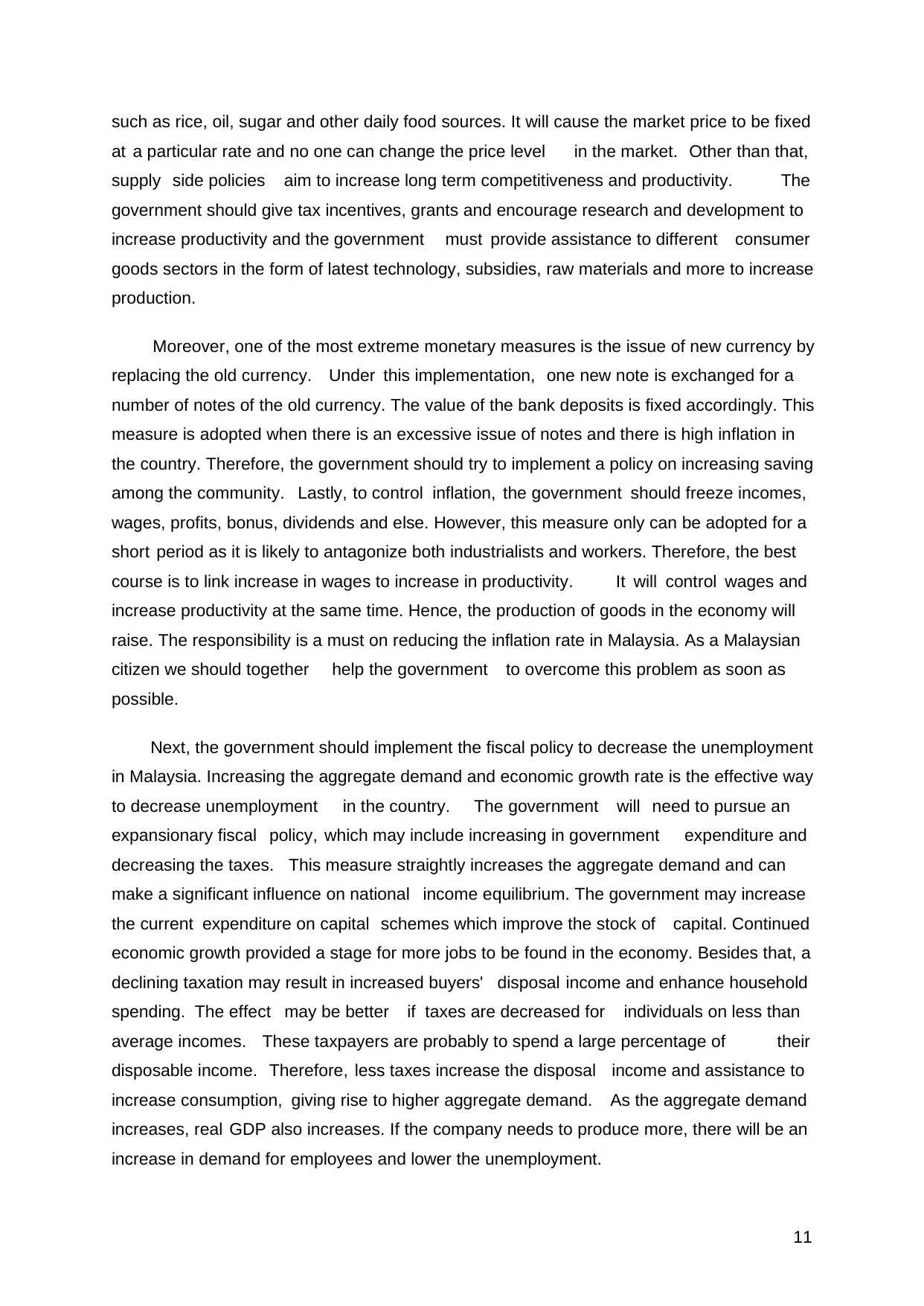
such as rice, oil, sugar and other daily food sources. It will cause the market price to be fixed
at a particular rate and no one can change the price level in the market. Other than that,
supply side policies aim to increase long term competitiveness and productivity. The
government should give tax incentives, grants and encourage research and development to
increase productivity and the government must provide assistance to different consumer
goods sectors in the form of latest technology, subsidies, raw materials and more to increase
production.
Moreover, one of the most extreme monetary measures is the issue of new currency by
replacing the old currency. Under this implementation, one new note is exchanged for a
number of notes of the old currency. The value of the bank deposits is fixed accordingly. This
measure is adopted when there is an excessive issue of notes and there is high inflation in
the country. Therefore, the government should try to implement a policy on increasing saving
among the community. Lastly, to control inflation, the government should freeze incomes,
wages, profits, bonus, dividends and else. However, this measure only can be adopted for a
short period as it is likely to antagonize both industrialists and workers. Therefore, the best
course is to link increase in wages to increase in productivity. It will control wages and
increase productivity at the same time. Hence, the production of goods in the economy will
raise. The responsibility is a must on reducing the inflation rate in Malaysia. As a Malaysian
citizen we should together help the government to overcome this problem as soon as
possible.
Next, the government should implement the fiscal policy to decrease the unemployment
in Malaysia. Increasing the aggregate demand and economic growth rate is the effective way
to decrease unemployment in the country. The government will need to pursue an
expansionary fiscal policy, which may include increasing in government expenditure and
decreasing the taxes. This measure straightly increases the aggregate demand and can
make a significant influence on national income equilibrium. The government may increase
the current expenditure on capital schemes which improve the stock of capital. Continued
economic growth provided a stage for more jobs to be found in the economy. Besides that, a
declining taxation may result in increased buyers' disposal income and enhance household
spending. The effect may be better if taxes are decreased for individuals on less than
average incomes. These taxpayers are probably to spend a large percentage of their
disposable income. Therefore, less taxes increase the disposal income and assistance to
increase consumption, giving rise to higher aggregate demand. As the aggregate demand
increases, real GDP also increases. If the company needs to produce more, there will be an
increase in demand for employees and lower the unemployment.
11
at a particular rate and no one can change the price level in the market. Other than that,
supply side policies aim to increase long term competitiveness and productivity. The
government should give tax incentives, grants and encourage research and development to
increase productivity and the government must provide assistance to different consumer
goods sectors in the form of latest technology, subsidies, raw materials and more to increase
production.
Moreover, one of the most extreme monetary measures is the issue of new currency by
replacing the old currency. Under this implementation, one new note is exchanged for a
number of notes of the old currency. The value of the bank deposits is fixed accordingly. This
measure is adopted when there is an excessive issue of notes and there is high inflation in
the country. Therefore, the government should try to implement a policy on increasing saving
among the community. Lastly, to control inflation, the government should freeze incomes,
wages, profits, bonus, dividends and else. However, this measure only can be adopted for a
short period as it is likely to antagonize both industrialists and workers. Therefore, the best
course is to link increase in wages to increase in productivity. It will control wages and
increase productivity at the same time. Hence, the production of goods in the economy will
raise. The responsibility is a must on reducing the inflation rate in Malaysia. As a Malaysian
citizen we should together help the government to overcome this problem as soon as
possible.
Next, the government should implement the fiscal policy to decrease the unemployment
in Malaysia. Increasing the aggregate demand and economic growth rate is the effective way
to decrease unemployment in the country. The government will need to pursue an
expansionary fiscal policy, which may include increasing in government expenditure and
decreasing the taxes. This measure straightly increases the aggregate demand and can
make a significant influence on national income equilibrium. The government may increase
the current expenditure on capital schemes which improve the stock of capital. Continued
economic growth provided a stage for more jobs to be found in the economy. Besides that, a
declining taxation may result in increased buyers' disposal income and enhance household
spending. The effect may be better if taxes are decreased for individuals on less than
average incomes. These taxpayers are probably to spend a large percentage of their
disposable income. Therefore, less taxes increase the disposal income and assistance to
increase consumption, giving rise to higher aggregate demand. As the aggregate demand
increases, real GDP also increases. If the company needs to produce more, there will be an
increase in demand for employees and lower the unemployment.
11
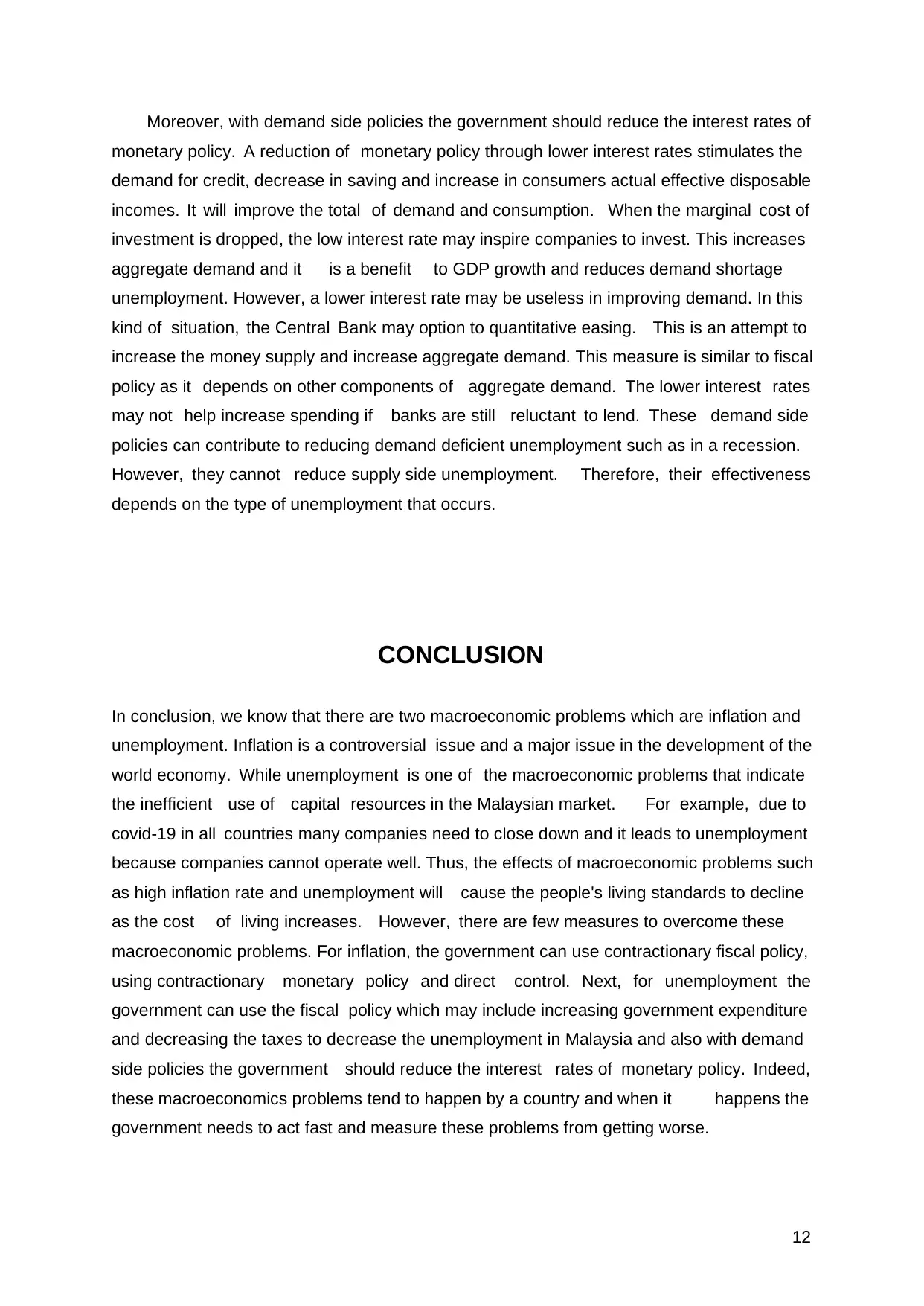
Moreover, with demand side policies the government should reduce the interest rates of
monetary policy. A reduction of monetary policy through lower interest rates stimulates the
demand for credit, decrease in saving and increase in consumers actual effective disposable
incomes. It will improve the total of demand and consumption. When the marginal cost of
investment is dropped, the low interest rate may inspire companies to invest. This increases
aggregate demand and it is a benefit to GDP growth and reduces demand shortage
unemployment. However, a lower interest rate may be useless in improving demand. In this
kind of situation, the Central Bank may option to quantitative easing. This is an attempt to
increase the money supply and increase aggregate demand. This measure is similar to fiscal
policy as it depends on other components of aggregate demand. The lower interest rates
may not help increase spending if banks are still reluctant to lend. These demand side
policies can contribute to reducing demand deficient unemployment such as in a recession.
However, they cannot reduce supply side unemployment. Therefore, their effectiveness
depends on the type of unemployment that occurs.
CONCLUSION
In conclusion, we know that there are two macroeconomic problems which are inflation and
unemployment. Inflation is a controversial issue and a major issue in the development of the
world economy. While unemployment is one of the macroeconomic problems that indicate
the inefficient use of capital resources in the Malaysian market. For example, due to
covid-19 in all countries many companies need to close down and it leads to unemployment
because companies cannot operate well. Thus, the effects of macroeconomic problems such
as high inflation rate and unemployment will cause the people's living standards to decline
as the cost of living increases. However, there are few measures to overcome these
macroeconomic problems. For inflation, the government can use contractionary fiscal policy,
using contractionary monetary policy and direct control. Next, for unemployment the
government can use the fiscal policy which may include increasing government expenditure
and decreasing the taxes to decrease the unemployment in Malaysia and also with demand
side policies the government should reduce the interest rates of monetary policy. Indeed,
these macroeconomics problems tend to happen by a country and when it happens the
government needs to act fast and measure these problems from getting worse.
12
monetary policy. A reduction of monetary policy through lower interest rates stimulates the
demand for credit, decrease in saving and increase in consumers actual effective disposable
incomes. It will improve the total of demand and consumption. When the marginal cost of
investment is dropped, the low interest rate may inspire companies to invest. This increases
aggregate demand and it is a benefit to GDP growth and reduces demand shortage
unemployment. However, a lower interest rate may be useless in improving demand. In this
kind of situation, the Central Bank may option to quantitative easing. This is an attempt to
increase the money supply and increase aggregate demand. This measure is similar to fiscal
policy as it depends on other components of aggregate demand. The lower interest rates
may not help increase spending if banks are still reluctant to lend. These demand side
policies can contribute to reducing demand deficient unemployment such as in a recession.
However, they cannot reduce supply side unemployment. Therefore, their effectiveness
depends on the type of unemployment that occurs.
CONCLUSION
In conclusion, we know that there are two macroeconomic problems which are inflation and
unemployment. Inflation is a controversial issue and a major issue in the development of the
world economy. While unemployment is one of the macroeconomic problems that indicate
the inefficient use of capital resources in the Malaysian market. For example, due to
covid-19 in all countries many companies need to close down and it leads to unemployment
because companies cannot operate well. Thus, the effects of macroeconomic problems such
as high inflation rate and unemployment will cause the people's living standards to decline
as the cost of living increases. However, there are few measures to overcome these
macroeconomic problems. For inflation, the government can use contractionary fiscal policy,
using contractionary monetary policy and direct control. Next, for unemployment the
government can use the fiscal policy which may include increasing government expenditure
and decreasing the taxes to decrease the unemployment in Malaysia and also with demand
side policies the government should reduce the interest rates of monetary policy. Indeed,
these macroeconomics problems tend to happen by a country and when it happens the
government needs to act fast and measure these problems from getting worse.
12
⊘ This is a preview!⊘
Do you want full access?
Subscribe today to unlock all pages.

Trusted by 1+ million students worldwide
1 out of 13
Related Documents
Your All-in-One AI-Powered Toolkit for Academic Success.
+13062052269
info@desklib.com
Available 24*7 on WhatsApp / Email
![[object Object]](/_next/static/media/star-bottom.7253800d.svg)
Unlock your academic potential
Copyright © 2020–2025 A2Z Services. All Rights Reserved. Developed and managed by ZUCOL.





